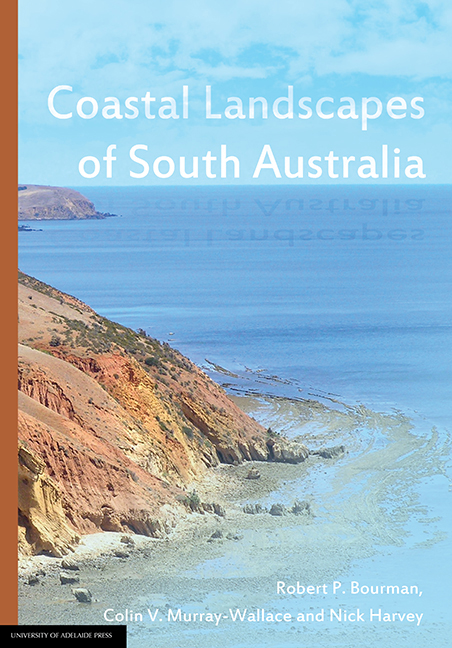Book contents
- Frontmatter
- Dedication
- Contents
- Preface
- Biographies
- Acknowledgements
- 1 Coastal landscapes of South Australia
- 2 The coast of metropolitan Adelaide
- 3 The Fleurieu Peninsula coast
- 4 The River Murray Estuary
- 5 The Coorong Coastal Plain and the Limestone Coast
- 6 The northern Gulf St Vincent tidal coastline (the Samphire Coast)
- 7 The Yorke Peninsula coastline
- 8 The northern Spencer Gulf coast
- 9 The Gulf Coast of Eyre Peninsula
- 10 The Bight Coast - West coast of Eyre Peninsula
- 11 Kangaroo Island
- 12 Explaining the coastal landscapes of South Australia - A synthesis
1 - Coastal landscapes of South Australia
Published online by Cambridge University Press: 25 July 2017
- Frontmatter
- Dedication
- Contents
- Preface
- Biographies
- Acknowledgements
- 1 Coastal landscapes of South Australia
- 2 The coast of metropolitan Adelaide
- 3 The Fleurieu Peninsula coast
- 4 The River Murray Estuary
- 5 The Coorong Coastal Plain and the Limestone Coast
- 6 The northern Gulf St Vincent tidal coastline (the Samphire Coast)
- 7 The Yorke Peninsula coastline
- 8 The northern Spencer Gulf coast
- 9 The Gulf Coast of Eyre Peninsula
- 10 The Bight Coast - West coast of Eyre Peninsula
- 11 Kangaroo Island
- 12 Explaining the coastal landscapes of South Australia - A synthesis
Summary
Introduction
People commonly have close affinities with coastlines, whether for recreation (swimming, fishing, boating, surfing, sunbathing), enjoying their generally milder climates, investigating their historical and cultural connections, admiring their inherent beauty or questioning the nature and formation of coastal landscapes. This book aims to assist people in interpreting coastal landforms, revealing how the coast has evolved and is continuing to do so under the influences of a range of processes acting upon a variety of geological settings. Developing an understanding of the ways in which coastlines have changed through time, by interpreting rock strata, landforms and coastal and marine processes, can add much to the enjoyment of coastal experiences. Study of coastal environments also offers opportunities to reconstruct past environments and to monitor ongoing changes that may relate to climatic changes. An understanding of coastal processes and development can also provide critical information relevant to the vulnerability of predicted rises in sea level and coastal flooding.
Coasts are very complex environments, representing the interaction of physical, chemical and biological processes. Located at the boundary between land and sea, coasts are among the most dynamic environments on Earth as tides, winds, waves, weathering processes and currents modify landscapes and produce a range of erosional and depositional landforms, the stability and fragility of which may also be influenced by flora and fauna. Repeated sea level changes over the past 2.6 million years, coupled with crustal movements, add to the complexity of coastal development. Thus the coastline of South Australia must be considered as a dynamic system in a state of constant flux. In addition, some coastal features are inherited from coastlines that were formed during past ages.
According to Geoscience Australia, the South Australian mainland coast is 3816 km long, with islands providing an additional 1251 km of coast, giving a total coastline of just over 5000 km. South Australian coastal landforms include cliffs, rocky outcrops and shore platforms, mangrove woodlands, mudflats, estuaries, extensive sandy beaches, coastal dunes and coastal barrier systems, as well as numerous nearshore reefs and islands. These coastal landforms have developed under the influence of a range of tidal conditions and wave regimes, varying from high energy on exposed open ocean coasts (for example, the west coast of Eyre Peninsula) to low energy in protected shorelines with high tidal ranges (such as in the northern gulfs).
- Type
- Chapter
- Information
- Coastal Landscapes of South Australia , pp. 1 - 44Publisher: The University of Adelaide PressPrint publication year: 2016



